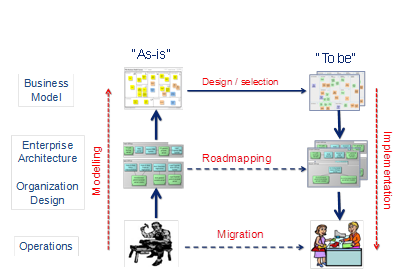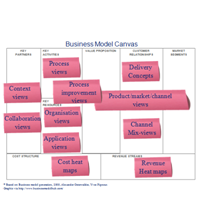The Business Model Canvas is a strategic management tool that provides an integrated and holistic view of an organization’s business model. It offers a single-page view of the organization’s business model and is a focal point for various strategic analyses, helping strategists map out the impact and interdependence of different strategic options.
The Business Model Canvas has proven to be a very useful tool to answer questions such as:
1. “We have the best idea in the world! At least… We think it’s pretty good… What’s next?”
2. “What do the fancy slides from the boardroom mean for us?”
3. “We need new ways to do business. What are our options?”
4. “We have a lot of projects but can’t do them all at the same time. What’s most important and what sequence makes sense?“
5. “Of course, we have all required architecture views and process models, but why are people not using them?”
6. “Focusing on doing things right is great, but don’t we need to think about doing the right things?”
7. “We find ourselves discussing the same things repeatedly. Is there a way to structure the discussion?”
The Business Model Canvas is useful in the following scenarios:
“We have the best idea in the world! At least… We think it’s pretty good… What’s next?”
A great product or service idea doesn’t bring you success instantly. Most ideas tend to come from the inside of companies, where you and your colleagues feel, see and experience that your team is very good at doing a certain job. The first thing to do, is to think of a value proposition and potential customers. Which problem are we solving? And whose problem is this? Are customers willing to pay, or do we need an alternative revenue model? The structure of the Business Model Canvas helps you add the other relevant elements necessary to turn your idea into an implementable business model. You have to check facts and figures, get in touch with potential customers and make a plan to create the necessary infrastructure. Consider yourself blessed working in a Greenfield environment! All options are open.
“What do the fancy slides from the boardroom really mean for us?”
In larger organizations, periodically new versions of the strategy are released. Sometimes because elements in the organization’s environment change, and often after changes in leadership. For the rest of the organization, it can be difficult to interpret strategy, since it is on a fairly high level of abstraction. There is a gap between strategy and the projects launched to implement this strategy. By assessing the strategic choices made, you can point out the places in your business model that are impacted by the strategy. Firstly, it helps you assess completeness, and fosters the discussion between those responsible for creating strategy and those responsible for executing it. This execution may lead to change in the way the enterprise does business and/or is structured. Insight into the impact of the strategy on the business model helps you to allocate resources to the right places in your business.
“We need new ways to do business. What are our options?”
The Business Model Canvas helps give insight into your current business model, but is at its best when applied for innovation. One effective approach is called the “epicentric-approach”, in which you use one block as a starting point and see what alternatives you can come up with. Any change will require changes in the other blocks. For example, in the case of customer-driven business model innovation, a new customer segment is targeted. This will lead to required changes in the value proposition, delivery channels, infrastructure, etc. Especially when well prepared and done with cross functional teams, the variation and creativity of the people in your organization will blow you away. After selecting the best ideas, people are invited to pitch their idea, as worked out in a Business Model Canvas. The audience will give tips to improve the ideas.
In later phases of the innovation process, scenario techniques can be used to get a better understanding of the benefits and risks related to the various alternative business model options.
“We have a lot of projects, but can’t do them all at the same time. What’s most important and what sequence makes sense?“
Use the canvas as a background for your projects. Where do they impact your business model? What about the blank spots? How do we deal with the overlap? The most important thing here, is to relate this to your work done in Strategy Impact Assessment. By using the Business Model Canvas as a model to connect strategy to your project portfolio, you provide insight into the strategic fit of your projects. When you are positioned in a larger organization, it makes sense to work your way down from business model, to enterprise architecture, to project portfolio.

A second step might be to have all project leaders create a canvas for their projects! This will take some time, but really gives direction to a project during its lifetime!
“Of course we have all required architecture views and process models, but why are people not using them?”
Some of this may have to do with the fact that the representation of a view doesn’t make sense to your audience (remember IEEE1471?). Or they just need a bit of guidance in order to feel comfortable in a world they’re less familiar with, starting from a context they do understand. Once your stakeholders get used to thinking in terms of Business Model Canvases (which happens really fast!), you can start using it as a basis for more detailed models that you are already creating. This helps architects and analysts get more traction with business management and marketing oriented people.
“Focusing on doing things right is great, but don’t we need to think about doing the right things?”

There must be some really lean CD case factories out there. But who still buys CD’s these days? Lean journeys often take off to save costs by improving process performance. By applying the Business Model Canvas as a starting point, people better understand the context of their processes. The collaboration helps create a team experience on one of the first days of the assignment. In some practices, we have seen that it fosters making choices and instantly stopping some activities. A common understanding of the value proposition is a good reference point for assessing activities and discussing their added value.
“We find ourselves discussing the same things over and over again. Is there something to structure the discussion?”
Many people are now using the canvas on a daily basis. Whether by sketching it on a piece of paper while chatting with a colleague or asking about the intended customer experience to get people out of the ever-enduring channel mix discussions. Search for completeness, write down your hypotheses, and work from the right side of the canvas (customers) via the center (value) to your own key activities. And feel free to ask the questions that need to be asked… even if that makes others uncomfortable.
ALSO READ: Business Analysis with the Business Model Canvas by guest blogger Remco Blom
The Business Model Canvas offers an integrated and holistic view of an organization’s business model, helping strategists map out the impact and interdependence of different strategic options. Knowledge of Business Modeling techniques is very powerful and useful in many different situations. If you want a demo of a Business Model Canvas, please contact us.
Managing Consultant & Chief Technology Evangelist at Bizzdesign
Marc contributes to Bizzdesign’s vision, market development, consulting, and coaching on digital business design and enterprise architecture. He also spreads the word on the Open Group’s ArchiMate® standard for enterprise architecture modeling, of which he has been managing the development. His expertise and interests range from enterprise and IT architecture to business process management.